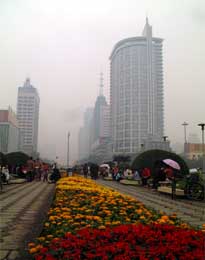Chengdu City is the capital of Sichuan Province now and called “Rongcheng City”. It is one of the famous historical and cultural cities in China and located at the middle reaches of the Minjiang River in the middle of Sichuan Province in central Chengdu Plain.
In the 4th century B. C, the king of Shu State moved his capital to this place and said, “we will make it a small city within the first year and a big one within the second. ” Hence the name Chengdu. During the past 2,300 years, Chengdu never changed its location and its name despite many upheavals.
With an area of 12,300 square km, the population of Chengdu is about 10 million. This city is divided into eight districts, four outlying cities and eight counties. About 3.5 million people reside in the city center.
Chengdu City is always reputed as “Land of Abundance” with its abundant water resources, fertile soil, opulent biological resources.
This modernization has no doubt been helped by the important role that Chengdu plays in terms of education and culture in China. Once one of the most important printing centers in the country, Chengdu has a long history as a destination for learned poets and artists to gather and seek inspiration. The great poet Du Fu, made his home here and today there are 14 colleges and an impressive university situated in the city.
Nestled amongst this affluence and development is another side to Chengdu. Traditional wooden Chinese architecture that once dominated this city can still be found in the outskirts although it is fast disappearing. What does still exist here however in abundance, is a great street life. Markets and street hawkers fill the streets dealing in everything you could possibly imagine, from snakes and snails to fortunes and foot scrubs.
Many travelers here are simply killing time or passing through en route to Tibet. This is however, a very pleasant city to do just this: feast on some great food and soak up some of the mellow atmosphere in one of the thousands of tea houses dotted about the city.



